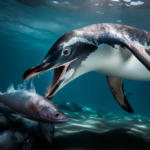Do Penguins Live in America?
Penguins are fascinating creatures that have captured the hearts of people all over the world. Known for their distinctive appearance and adorable waddle, penguins are often associated with cold, icy environments like Antarctica. However, many people wonder if penguins also live in America. In this article, we will explore the distribution of penguins and discover whether these charismatic birds can be found in the Americas. So, let’s dive in and uncover the fascinating world of penguins!
Key Takeaways
- Penguins do not naturally live in America.
- The majority of penguin species are found in the Southern Hemisphere, particularly in Antarctica.
- Some species of penguins can be found in South America, such as the Galapagos penguin.
- Penguins in American zoos are typically housed in controlled environments to mimic their natural habitats.
The Geographic Distribution of Penguins

Penguins are fascinating creatures that have captured the hearts of people all over the world. While they are commonly associated with Antarctica, their geographic distribution extends beyond the icy continent. In this section, we will explore where penguins live and take a closer look at their presence in South America and North America.
A. Where Do Most Wild Penguins Live?
When we think of penguins, our minds often conjure up images of vast ice-covered landscapes in Antarctica. Indeed, Antarctica is home to several penguin species, including the Emperor Penguin, Adélie Penguin, and Chinstrap Penguin. These species have adapted to the harsh conditions of the Antarctic environment, where they form large colonies and brave the freezing temperatures to raise their young.
However, it’s important to note that not all penguins live in Antarctica. Penguins can be found in various regions of the Southern Hemisphere, including South America, Africa, and the Galapagos Islands. These regions offer different habitats and climates that support different penguin species.
B. Penguins in South America: A Closer Look
South America is home to several penguin species, making it an important region for penguin conservation and research. One of the most well-known penguin species in South America is the Magellanic Penguin. These charming birds can be found along the coasts of Argentina and Chile, where they nest in burrows dug into the ground. They are known for their distinctive black and white plumage and their playful nature.
Another notable penguin species in South America is the Galapagos Penguin. As the name suggests, these penguins reside in the Galapagos Islands, which are located off the coast of Ecuador. The Galapagos Penguin is the only penguin species that lives north of the equator, making it unique among its counterparts. These penguins have adapted to the warm climate of the Galapagos Islands and can often be seen basking in the sun to regulate their body temperature.
C. The Presence of Penguins in North America
While penguins are not native to North America, there are a few places where you can see them in this region. Many zoos and aquariums in North America have penguin exhibits, allowing visitors to observe these incredible birds up close. These exhibits provide educational opportunities for people to learn about penguin behavior, adaptation, and conservation.
Additionally, some penguin species have been known to make occasional appearances along the coasts of North America. For example, the occasional stray penguin from South America may find its way to the shores of the United States or Canada. These occurrences are rare but can create excitement among local communities and wildlife enthusiasts.
It’s important to note that the presence of penguins in North America is not a result of natural colonization. Penguins are adapted to specific environments and rely on their natural habitats for survival. While it may be tempting to imagine penguins waddling along the beaches of North America, their true homes are in the Southern Hemisphere.
In conclusion, while penguins are not native to America, they can be found in various regions of the Southern Hemisphere, including South America. South America is home to several penguin species, such as the Magellanic Penguin and the Galapagos Penguin. North America, on the other hand, provides opportunities for people to observe penguins in zoos and aquariums. Understanding the geographic distribution of penguins helps us appreciate the diversity of these remarkable birds and the importance of their conservation efforts.
Understanding Penguin Habitats

A. Why Do Penguins Live in the Cold?
Penguins are fascinating creatures that have adapted to live in some of the harshest environments on Earth. While many people associate penguins with Antarctica, they can actually be found in various regions around the world, including South America. So, why do penguins choose to live in such cold climates?
-
Adaptation to Cold: Penguins have evolved to thrive in cold environments. Their bodies are covered in a layer of insulating feathers that help keep them warm. Additionally, they have a thick layer of blubber that acts as an extra layer of insulation.
-
Abundance of Food: Cold waters are rich in nutrients, which attract an abundance of fish and krill, the primary food sources for penguins. These cold-water ecosystems provide the perfect conditions for penguins to find ample food to sustain themselves and their chicks.
-
Predator Protection: The cold waters surrounding penguin habitats also serve as a natural barrier against predators. Many of the predators that penguins face, such as seals and sea lions, are less likely to venture into the frigid waters. This provides a level of protection for penguins and their colonies.
B. Do Penguins Live Alone? The Social Structure of Penguins
Contrary to popular belief, penguins are not solitary creatures. They are highly social animals that live in colonies, ranging in size from a few dozen to several thousand individuals. These colonies are an integral part of penguin society and serve several important purposes.
-
Protection and Safety: Living in colonies provides penguins with safety in numbers. By huddling together, they can protect themselves from the harsh elements and predators. The tightly packed group also helps to conserve body heat, keeping each penguin warm in the cold Antarctic climate.
-
Breeding and Raising Chicks: Penguins are monogamous creatures, meaning they mate with the same partner for life. Within a colony, penguins form pairs and engage in elaborate courtship rituals. Once the female lays an egg, both parents take turns incubating it and caring for the chick once it hatches. The presence of a colony provides a supportive environment for successful breeding and chick rearing.
-
Communication and Recognition: Penguins have a unique way of identifying and communicating with each other. They use a combination of vocalizations, body postures, and displays to recognize their mates and offspring. Living in close proximity within a colony allows penguins to easily locate and interact with their family members.
In conclusion, penguins are well-suited to live in cold habitats due to their physical adaptations and the abundance of food found in these environments. They are highly social creatures that form colonies for protection, breeding, and communication purposes. Understanding the habitat and social structure of penguins is crucial for their conservation and the preservation of their unique way of life.
The Intriguing Case of Penguins in America

A. Do Penguins Live in America?
When we think of penguins, the image of these adorable flightless birds waddling through icy landscapes in Antarctica often comes to mind. However, did you know that penguins also inhabit parts of America? While the majority of penguin species are found in the Southern Hemisphere, there are a few species that call America their home.
Penguin Species in America
In South America, specifically along the coasts of Chile, Argentina, and the Falkland Islands, you can find several species of penguins. The most well-known of these is the Magellanic penguin, which is native to South America. These charming birds are known for their distinctive black and white plumage and their playful nature.
American Penguin Habitats
Penguins in South America typically inhabit coastal areas, where they can find an abundance of food in the surrounding waters. They prefer rocky shorelines and islands, where they can build their nests and raise their young. These habitats provide protection from predators and offer easy access to the ocean for hunting.
B. Why Do Penguins Live in South America?
You might be wondering why penguins choose to live in South America. The answer lies in the cold ocean currents that flow along the western coast of the continent. These currents bring nutrient-rich waters from the depths of the ocean, creating a bountiful feeding ground for penguins and other marine life.
Penguin Migration
Penguins are known for their remarkable ability to migrate long distances in search of food. Some penguin species in South America, such as the Humboldt penguin, undertake extensive migrations, traveling hundreds of kilometers to find the best feeding grounds. These migrations are essential for their survival and ensure they have access to a steady food supply.
Galapagos Penguins
In addition to mainland South America, penguins also inhabit the Galapagos Islands, which are located off the coast of Ecuador. The Galapagos penguin is the only species of penguin that lives north of the equator. These unique birds have adapted to the warm climate of the Galapagos, where they can be found nesting in lava rock crevices and swimming in the surrounding waters.
C. Do Penguins Live in the US?
While penguins are not native to the United States, you can still find them in several zoos and aquariums across the country. These institutions provide a safe and controlled environment for penguins to thrive, allowing visitors to observe and learn about these fascinating creatures up close.
North American Zoos with Penguins
Many zoos in North America have dedicated exhibits that mimic the natural habitats of penguins. These exhibits often include large pools for swimming, rocky areas for nesting, and even artificial snow to recreate the chilly conditions that penguins prefer. Some notable zoos with penguin exhibits include the San Diego Zoo, the Bronx Zoo, and the Shedd Aquarium in Chicago.
Penguin Conservation in America
Conservation efforts are also underway to protect penguin populations in America. Researchers and conservationists work tirelessly to study penguins’ behavior, breeding patterns, and diet to better understand their needs and ensure their survival. These efforts include monitoring penguin colonies, implementing measures to mitigate the impact of climate change, and raising awareness about the importance of penguin conservation.
In conclusion, while penguins are most commonly associated with Antarctica, it is fascinating to discover that they also live in America. From the rocky coasts of South America to the carefully curated exhibits in North American zoos, penguins have found a place in the hearts of people around the world. Their unique adaptations, playful behavior, and conservation efforts make them a truly captivating species to learn about and admire.
Conclusion
In conclusion, while penguins are not native to America, there are a few species that can be found in certain regions of the continent. The Galapagos penguin is the only species that resides in the Americas, specifically on the Galapagos Islands off the coast of Ecuador. Additionally, some penguins may occasionally migrate to the southern parts of South America, such as Argentina and Chile, during the non-breeding season. However, it is important to note that these penguins are not permanent residents and their presence in these areas is limited. Overall, if you’re looking to see penguins in their natural habitat, it’s best to visit Antarctica or other regions where these fascinating creatures are more abundant.
Frequently Asked Questions
1. Can penguins live in South America?
Yes, certain species of penguins can live in South America. The most notable of these is the Galapagos penguin, which is found on the Galapagos Islands off the coast of Ecuador.
2. Do penguins live alone?
No, penguins are social birds that live in large colonies for most of the year. They gather together for breeding and molting, and often hunt in groups as well.
3. Why do penguins live in the cold?
Penguins are adapted to live in cold climates. Their bodies are designed to withstand freezing temperatures, with features such as a layer of insulating blubber, tightly packed feathers that provide waterproofing and warmth, and a counter-current heat exchange system in their flippers and legs.
4. How cold is it where penguins live?
The temperature in penguin habitats can vary greatly depending on the species and location. In Antarctica, where Emperor and Adelie penguins live, temperatures can drop below -60 degrees Celsius. However, Galapagos penguins live near the equator where temperatures are much warmer.
5. Are there penguins in the USA?
There are no wild penguins in the USA, but many zoos across the country house various species of penguins. The most common species in North American zoos are the African, King, and Rockhopper penguins.
6. Where do penguins live in North America?
While there are no wild penguins native to North America, many zoos across the continent house penguins. These include the San Diego Zoo, the New England Aquarium, and the Central Park Zoo, among others.
7. Do penguins live in the US?
There are no wild penguins in the US, but many zoos and aquariums across the country house various species of penguins for research, conservation, and public education purposes.
8. Where do most wild penguins live?
Most wild penguins live in the Southern Hemisphere, particularly in Antarctica. However, some species can be found in South America, Africa, New Zealand, and the Galapagos Islands.
9. Do penguins live in America?
While there are no wild penguins native to North America, many zoos and aquariums house penguins. In South America, you can find wild penguins, particularly in the Galapagos Islands and along the coasts of Argentina and Chile.
10. Why do penguins live in South America?
Certain species of penguins live in South America because the climate and conditions are suitable for their survival. For example, the Galapagos penguin lives on the Galapagos Islands because the cold, nutrient-rich waters brought by the Humboldt and Cromwell currents provide an abundant supply of food.




